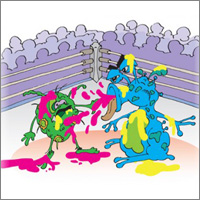
Bacteria hold a vast reservoir of compounds with therapeutic potential. They use these compounds, known as secondary metabolites, to protect themselves against their enemies. We use them in many antibiotics, anti-inflammatories and other treatments.
Scientists interested in developing new medicines have no shortage of places to look for secondary metabolites. There are an estimated 120,000 to 150,000 bacterial species on Earth. Each species is capable of producing hundreds of secondary metabolites, but often only under specific ecological conditions. The challenge for researchers is figuring out how to coax the bacteria to produce these compounds.
Now, Brian Bachmann and John McLean of Vanderbilt University and their teams have shown that by creating “fight clubs” where bacteria compete with one another, they can trigger the bacteria to make a wide diversity of molecules, including secondary metabolites.
The Vanderbilt researchers pitted Nocardiopsis, a soil-dwelling bacterial species, against each of four other bacterial species by growing them in the same petri dishes. They also grew cultures of each of the bacterial species without competitors.
They found that Nocardiopsis produced a greater quantity and variety of biological molecules when competing with each of the other species than when growing alone.
To determine which of those molecules might be secondary metabolites, the scientists developed a computational tool called self-organizing metabolomics maps (SOM). The SOMs helped them identify the secondary metabolites by their distinctive size-weight ratios.
The SOMs revealed that one secondary metabolite that the scientists named ciromicin (after a Latin word meaning war/cite/disturb/invoke) was produced by Nocardiopsis only when it grew with another bacterial species called Rhodococcus wratislaviensis. The scientists suspect ciromicin may have therapeutic value because it is similar in shape to several FDA-approved antibiotics and, in laboratory studies, has shown the potential to limit tumor growth.
Bachmann and McLean are hopeful that the techniques they developed will help identify many more secondary metabolites with promising therapeutic potential.
This work was funded in part by NIH grants R01GM092218 and T32GM065086.


I Promise to comeback and read this post because it has nice content